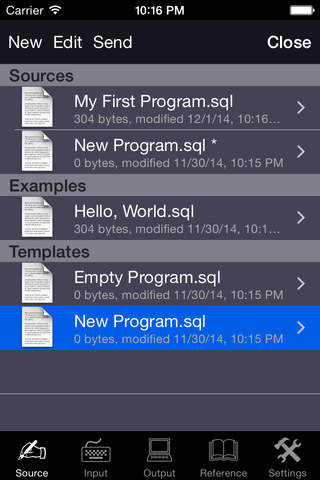
SQL Programming Language
SQL programming language for iPad, iPhone and iPod touch based on SQLite engine. Programming language is a perfect tool for studying, complex mathematical calculation, entertainment and many other useful tasks. The application is especially useful for learning the SQL programming language. You have to buy compilations inside the application. Internet connection is required.
- The great programming tool on the AppStore.
- Your programming language for iOS is amazing!
* FEATURES *
- Compile and run your program.
- Text input before program run and text output.
- Enhanced source code editor with syntax highlighting, line numbers, color themes and additional keyboard.
- Online language reference and several program samples.
* LIMITATIONS *
- Internet connection is required to compile and run a program.
- Graphics, network, file system and real-time input are not supported.
- Maximum running time of a program is 15 seconds.
Thanks for using the application!
====================================
SQL is a programming language designed for managing data in relational database management systems (RDBMS).
Originally based upon relational algebra and tuple relational calculus, its scope includes data insert, query, update and delete, schema creation and modification, and data access control.
SQL was one of the first commercial languages for Edgar F. Codds relational model, as described in his influential 1970 paper, "A Relational Model of Data for Large Shared Data Banks". Despite not adhering to the relational model as described by Codd, it became the most widely used database language. Although SQL is often described as, and to a great extent is, a declarative language, it also includes procedural elements. SQL became a standard of the American National Standards Institute (ANSI) in 1986, and of the International Organization for Standards (ISO) in 1987. Since then, the standard has been enhanced several times with added features. However, issues of SQL code portability between major RDBMS products still exist due to lack of full compliance with, or different interpretations of, the standard. Among the reasons mentioned are the large size and incomplete specification of the standard, as well as vendor lock-in.
SQL was initially developed at IBM by Donald D. Chamberlin and Raymond F. Boyce in the early 1970s. This version, initially called SEQUEL (Structured English Query Language), was designed to manipulate and retrieve data stored in IBMs original quasi-relational database management system, System R, which a group at IBM San Jose Research Laboratory had developed during the 1970s. The acronym SEQUEL was later changed to SQL because "SEQUEL" was a trademark of the UK-based Hawker Siddeley aircraft company.
The first Relational Database Management System (RDBMS) was RDMS, developed at MIT in the early 1970s, soon followed by Ingres, developed in 1974 at U.C. Berkeley. Ingres implemented a query language known as QUEL, which was later supplanted in the marketplace by SQL.
After testing SQL at customer test sites to determine the usefulness and practicality of the system, IBM began developing commercial products based on their System R prototype including System/38, SQL/DS, and DB2, which were commercially available in 1979, 1981, and 1983, respectively.



